Our research
Our leading scientific research program ensures we make informed decisions and investments in services for our customers.
From water quality management, wastewater treatment and alternative water sources to energy efficiency, liveability, environmental protection and potential impacts of climate change, our researchers help find ways to keep delivery of water and wastewater services cost-effective while building a sustainable future for South Australia.
Investment in research helps us deliver safe, smart, reliable and affordable services and prepare for the future for the benefit of our customers and the community.
Here are three current research projects we’re working on.
To protect the health and wellbeing of all South Australians and help stop the spread of COVID-19, we work with SA Health on a range of surveillance measures to rapidly detect COVID-19 in the community.
Many years of investment in research into methods of sampling and analysing pathogens in water and wastewater meant in 2020 we had the world-leading expertise and capability to rapidly implement ways to detect COVID-19 in wastewater.
COVID-19 sewage surveillance testing occurs at a number of wastewater treatment plants and at selected sub-catchment locations across South Australia to help track COVID-19 infections in the community and provide early warning of cases.
It is being used alongside clinical testing results to support our state’s COVID-19 testing system .
Reporting an unexpected detection, either a virus at a new location or more virus than expected based on case numbers, has helped SA Health investigate further and update the community more efficiently and effectively when needed.
As a world leader in this research, we also deliver training and advice to Cambodia, Thailand and Vietnam to support them to establish their own COVID-19 sewage testing programs thanks to project funding by Department of Foreign Affairs and Trade and partnerships with our colleagues in the wider Australian water industry.
For more information visit the SA Health website or check out our video on COVID-19 sewage surveillance.
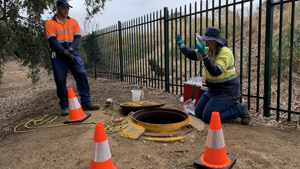
COVID sewage surveillance in action
Seagrasses are a vital element of a marine ecosystem that, among other roles, provide a nursery for various fish species. Loss of seagrass in Adelaide’s coastal waters has occurred through the impact of nutrients and suspended solids present in land-based discharges such as wastewater treatment plants.
Since the 1990s we have reduced the amount of nutrients and matter discharge by 70 per cent and 50 per cent respectively, leading to the recovery of more than 10,000 hectares of seagrasses, particularly in waters deeper than 10 m. As seagrasses are slow-growing, further gains are predicted in the next decade.
We have achieved these reductions through various research initiatives and in partnership with local universities, government departments and NGOs. The focus of these partnerships has been:
- understanding the trajectory of seagrass cover over time
- simulating and assessing the benefit of mitigation options
- exploring innovative ways to restore seagrass habitat.
To promote additional recruitment and accelerate passive rehabilitation, we are:
- investigating how to address the various barriers to seagrass regrowth, such as wave action and resuspension of sediments in stormwater
- developing avenues for active restoration using seeds or the protection afforded by nature-based solutions such as shellfish reefs.
The combination of adaptive management and research is helping guide how we prioritise future on-ground actions to enable proactive environmental leadership and the conservation of coastal ecosystem health for generations to come.
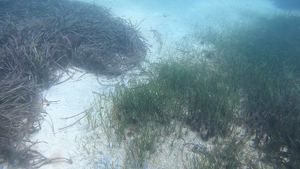
Growth of Zostera seagrass
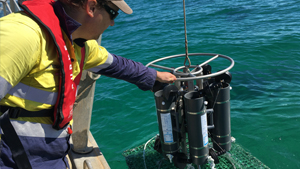
Deploying our water quality sampler. Seagrasses are very sensitive to water quality, so understanding why and how water quality changes is an important part of their restoration.
The use of chemicals to treat drinking water is a necessary part of producing safe, clean drinking water for our customers.
Optimising how we use chemicals to treat drinking water is important to ensure quality is maximised, quantities of chemicals and resultant residues are minimised, and our costs are controlled.
An initiative underway is making a change to the quantity of chemicals we use to continue to guarantee our tap water is safe to drink, but also minimise environmental impacts and lowers our costs.
The key water treatment chemical is a coagulant which forces contaminants dispersed in source water to settle out. Since their construction, all our metropolitan plants have successfully used alum to do this.
We undertook a survey of advanced coagulants to look for performance and cost-of-treatment benefits. A consistent scientific process using smart performance measures was applied through extensive laboratory trials. Through this process, an alternative coagulant, aluminium chlorohydrate (ACH), was identified as better meeting current and future treatment requirements.
The use of ACH results in:
- less use of other chemicals (lime and sodium hydroxide)
- reduced quantity of sludge to process and transport
- production of less aggressive water to our pipes thereby increasing their lifespan and reducing replacement costs.
Full scale water treatment plant trials confirmed the laboratory findings and highlighted the positive impact of an alternative coagulant on downstream processes. We are now implementing this change in water treatment across a number of our plants and the benefits are being realised, such as less waste product, which means reduced impact on the environment and lower waste disposal costs.
Providing safe and clean drinking water for our customers is a high priority and is guided by the Australian Drinking Water Guidelines.
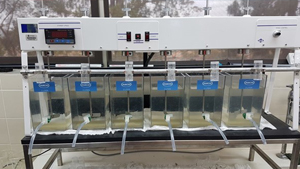
Lab testing of coagulant chemicals
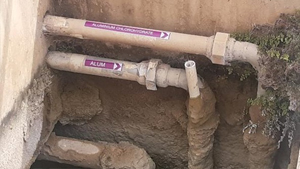
Installation of ACH dosing pipe at Morgan Water Treatment Plant
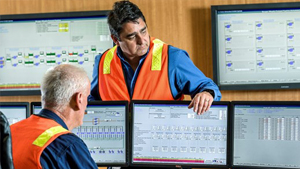
Morgan Water Treatment Plant operators monitor the progress of ACH dosing

